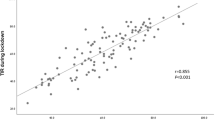Abstract
Aims
The aim of the study was (a) to compare annual glycemic control in pediatric patients with type 1 diabetes mellitus (T1DM) who used a healthcare-funded continuous glucose monitoring system (RT-CGMS) to that of those who performed self-monitoring blood glucose (SMBG) only, in a real-life setting, and (b) to define parameters associated with compliance and glycemic control.
Methods
A total of 149 youth with T1DM (52.3 % females), mean age 11.8 ± 3.6 years, and 83 in the CGMS group were followed prospectively for 12 months. Glycemic control parameters and compliance to RT-CGMS were assessed periodically.
Results
Glycemic parameters did not differ significantly between the groups during follow-up periods. The time spent with RT-CGMS decreased and only 38 % used it for more than 75 % of the time during the 12 months (consistent users). Mean HbA1c decreased by 0.27 % in consistent users and increased by 0.21 % among intermittent users (used RT-CGMS less than 75 % of time), p = 0.013. Consistent users were younger 10. 6 ± 4.2 vs. 12.5 ± 3.6, p = 0.07, and had higher frequency of SMBG at baseline, 10.6 ± 4.9 vs. 6.3 ± 2.8, p = 0.011.
Conclusions
The adoption of RT-CGMS was low, even in a healthcare system that funds its use. Caregivers should consider patient characteristics when recommending RT-CGMS use.

Similar content being viewed by others
References
Reichard P, Nilsson BY, Rosenqvist U; The Diabetes Control and Complications Trial Research Group (1993) The effect of intensive treatment of diabetes on the development and progression of long-term complications in insulin-dependent diabetes mellitus. N Engl J Med 329(5):304–309
The Diabetes Control and Complications Trial Research Group (1994) Effect of intensive diabetes treatment on the development and progression of long-term complications in adolescents with insulin-dependent diabetes mellitus: diabetes control and complications trial. J Pediatr 125:177–188
Petitti DB, Klingensmith GJ, Bell RA et al (2009) Glycemic control in youth with diabetes: the SEARCH for diabetes in Youth Study. J Pediatr 155:668–672 (e661–663)
Wood JR, Miller KM, Maahs DM et al (2013) Most youth with type 1 diabetes in the T1D exchange clinic registry do not meet American Diabetes Association or International Society for Pediatric and Adolescent Diabetes clinical guidelines. Diabetes Care 36(7):2035–2037
Beck RW, Tamborlane WV, Bergenstal RM, Miller KM, DuBose SN, Hall CA (2012) The T1D exchange clinic registry. J Clin Endocrinol Metab 97:4383–4389
Golicki DT, Golicka D, Groele L, Pankowska E (2008) Continuous glucose monitoring system in children with type 1 diabetes mellitus: a systematic review and meta-analysis. Diabetologia 51:233–240
Tamborlane WV, Beck RW, Bode BW et al (2008) Continuous glucose monitoring and intensive treatment of type 1 diabetes. N Engl J Med 359:1464–1476
Norgaard K, Scaramuzza A, Bratina N et al (2013) Routine sensor-augmented pump therapy in type 1 diabetes: the INTERPRET study. Diabetes Technol Ther 15:273–280
Nallamothu BK, Hayward RA, Bates ER (2008) Beyond the randomized clinical trial: the role of effectiveness studies in evaluating cardiovascular therapies. Circulation 118:1294–1303
Mortensen HB (2002) Findings from the Hvidore Study Group on childhood diabetes: metabolic control and quality of life. Horm Res 57(Suppl 1):117–120
Wentholt IM, Hoekstra JB, Devries JH (2007) Continuous glucose monitors: the long-awaited watch dogs? Diabetes Technol Ther 9:399–409
Cemeroglu AP, Stone R, Kleis L, Racine MS, Postellon DC, Wood MA (2010) Use of a real-time continuous glucose monitoring system in children and young adults on insulin pump therapy: patients’ and caregivers’ perception of benefit. Pediatr Diabetes 11:182–187
Yeh HC, Brown TT, Maruthur N et al (2012) Comparative effectiveness and safety of methods of insulin delivery and glucose monitoring for diabetes mellitus: a systematic review and meta-analysis. Ann Intern Med 157:336–347
Mastrototaro J, Welsh JB, Lee S (2010) Practical considerations in the use of real-time continuous glucose monitoring alerts. J Diabetes Sci Technol 4:733–739
Pickup JC, Freeman SC, Sutton AJ (2011) Glycaemic control in type 1 diabetes during real time continuous glucose monitoring compared with self monitoring of blood glucose: meta-analysis of randomised controlled trials using individual patient data. BMJ 343:d3805
Langendam M, Luijf YM, Hooft L, Devries JH, Mudde AH, Scholten RJ (2012) Continuous glucose monitoring systems for type 1 diabetes mellitus. Cochrane Database Syst Rev 1:CD008101
Beck RW, Buckingham B, Miller K et al (2009) Factors predictive of use and of benefit from continuous glucose monitoring in type 1 diabetes. Diabetes Care 32:1947–1953
Battelino T, Conget I, Olsen B et al (2012) The use and efficacy of continuous glucose monitoring in type 1 diabetes treated with insulin pump therapy: a randomised controlled trial. Diabetologia 55:3155–3162
Acknowledgments
We thank Ms. Cindy Cohen for her editorial assistance.
Conflict of interest
The authors Rachmiel Marianna, Landau Zohar, Mazor Aronovitch Kineret, Loewenthal Neta, Ben-Ami Michal, Levy-Shraga Yael, Modan-moses Dalit, Haim Alon, Abiri Shirli, Pinhas-Hamiel Orit, Boaz Mona declare that they have no conflict of interest.
Human and Animal rights
All procedures followed were in accordance with the ethical standards of the responsible committees on human experimentation (institutional and national) and with the Helsinki Declaration of 1975, as revised in 2008.
Informed consent
Informed consent was obtained from participants for being included in the study according to Ethics Committees requirements.
Author information
Authors and Affiliations
Corresponding author
Additional information
Managed by Massimo Porta.
M. Rachmiel and Z. Landau have equally contributed to this work.
Trial registry number: NCT01525784.
Rights and permissions
About this article
Cite this article
Rachmiel, M., Landau, Z., Boaz, M. et al. The use of continuous glucose monitoring systems in a pediatric population with type 1 diabetes mellitus in real-life settings: the AWeSoMe Study Group experience. Acta Diabetol 52, 323–329 (2015). https://doi.org/10.1007/s00592-014-0643-6
Received:
Accepted:
Published:
Issue Date:
DOI: https://doi.org/10.1007/s00592-014-0643-6




